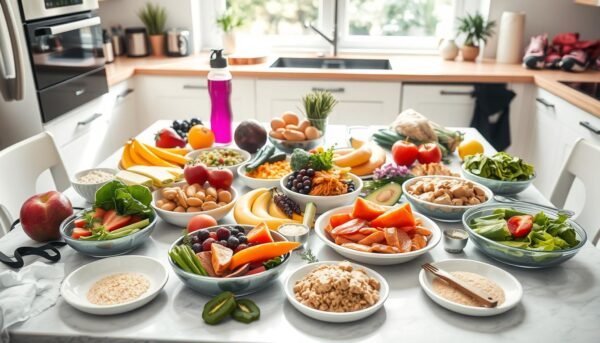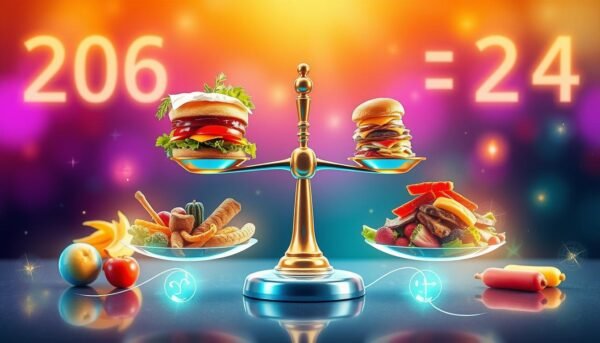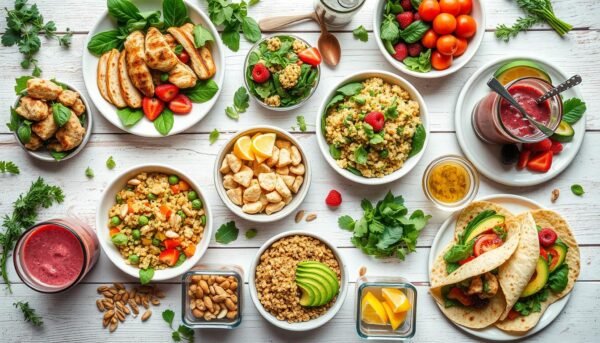I’ve always battled with weight, looking for quick fixes. Losing 50 pounds in a few days seems tempting. But, it’s not safe or realistic.
We’ll look into safe weight loss and debunk myths. You’ll learn how to reach your goals in a healthy way.
Understanding Realistic Weight Loss Expectations

Getting healthy through diet and exercise is a journey, not a quick fix. When it comes to losing weight, it’s key to set realistic goals. Fast weight loss might seem good, but it’s often not safe and can harm your health.
The Science Behind Safe Weight Loss
Healthy weight loss means eating right and exercising regularly. Try to lose 1 to 2 pounds (0.5 to 1 kilogram) each week. This pace is safe and doable. Losing 5% of your weight can also help with heart disease and diabetes.
Why Quick Fixes Don’t Work
Crash diets and extreme calorie cuts don’t work well. They can mess up your metabolism and health. Real weight loss comes from making lasting lifestyle changes.
Setting Achievable Goals
When setting weight loss goals, mix action and outcome goals. For example, “Walk 30 minutes daily” and “Lose 10 pounds.” This way, you can see your progress and stay motivated. Focus on making small, lasting changes to your diet and exercise, not quick fixes.
Adding a diet plan and exercise to your life is key to reaching your weight loss goals. By understanding safe weight loss and setting realistic goals, you can start a journey to a healthier lifestyle that lasts.
The Truth About Rapid Weight Loss and Its Risks

Looking to lose weight fast? It’s easy to get caught up in quick fixes like diet pills or extreme diets. But, the truth is, fast weight loss can harm your health.
In the U.S., people spend about $33 billion each year on weight loss products. Fast weight loss means losing more than 2 pounds a week. This can be done through very low-calorie diets or other extreme methods. While these might work at first, they can hurt your health in the long run.
- Rapid weight loss can cause nutritional deficiencies, electrolyte imbalances, changes in metabolism and bone density, and psychological effects like stress and anxiety.
- Drastic weight loss methods are often unsustainable and may result in regaining the weight, sometimes even more than what was initially lost.
A better way is to lose weight slowly and steadily. This means eating right and exercising regularly. This method is safer and more effective for keeping the weight off for good.
Remember, losing more than 2 pounds per week could pose risks to your health. Always talk to a doctor before starting a fast weight loss plan, especially if you have health issues.
The best strategy is to control your portions, eat fewer calories, and burn fat. This might take longer, but it’s the best way to keep your weight off and stay healthy.
Why People Want to lose 50 pounds Quickly

Many people want to lose 50 pounds fast. They think it’s easy and quick. But, losing weight the right way takes time and focuses on health.
Common Misconceptions About Fast Weight Loss
People think fast weight loss is the answer. But, it’s not. Quick diets can harm your health and make it hard to keep weight off.
Understanding Your Starting Point
How fast you lose weight depends on your starting weight. If you’re heavier, you might lose weight faster at first. But, this fast loss isn’t lasting. It’s key to know your body and health before starting to lose weight.
Health Implications of Rapid Weight Loss
Fast weight loss can hurt your health. It can cause muscle loss, fatigue, and more. These problems can make it hard to stay healthy over time. A balanced weight loss plan is better for your health.
Knowing the truth about weight loss helps you make a better plan. A slow and steady approach is best for lasting success in body transformation and metabolism boosting.
Calculating Your Daily Caloric Needs for Weight Loss

To lose weight well, knowing your daily calorie needs is key. You need to eat less than your body burns but still get the nutrients it needs.
Your Basal Metabolic Rate (BMR) and Total Daily Energy Expenditure (TDEE) help figure out your daily calorie intake. Your BMR is how many calories your body needs for basic functions. Your TDEE includes your activity level to show your total calorie burn.
A good calorie deficit for losing weight is 500-750 calories less than your TDEE. This slow loss helps you stay healthy and avoid feeling too hungry. The NIH Body Weight Planner can help estimate your weight loss based on your details.
Your calorie needs can change based on your metabolism boosting and portion control habits. It’s important to adjust your calorie intake and activity levels for lasting weight management.
| Age Range | Female Calorie Needs (kcal/day) | Male Calorie Needs (kcal/day) |
|---|---|---|
| 19-30 years | 2,000-2,400 | 2,400-3,000 |
| 31-60 years | 1,600-2,200 | 2,200-3,000 |
| 2-4 years | 1,000-1,400 | 1,000-1,600 |
| 5-8 years | 1,200-1,800 | 1,200-2,000 |
Knowing your daily calorie needs and making a sustainable calorie deficit is crucial for long-term weight loss. Use portion control and metabolism boosting strategies to help you lose weight.
The Role of Metabolism in Short-Term Weight Loss

Metabolism is key for losing weight, especially in the short term. It tells us how many calories we burn at rest and when we’re active. This makes it a big part of any weight loss plan.
Factors Affecting Metabolic Rate
Many things can change our metabolic rate. Our age, sex, muscle mass, and how active we are can all play a part. As we age, our metabolism slows down, making it harder to lose weight. People with more muscle tend to have a faster metabolism.
How to Boost Your Metabolism Naturally
There are ways to naturally boost your metabolism. Regular exercise, especially strength training, can build muscle and help burn fat. Eating protein-rich foods also helps, as your body burns more calories digesting protein.
Understanding BMR and TDEE
To manage your weight well, you need to know about BMR and TDEE. BMR is how many calories you burn at rest. TDEE includes calories from daily activities and exercise routines. Knowing these can help you plan for short-term weight loss.
Understanding metabolism’s role in weight loss is important. By boosting your metabolic rate, you can lose weight in the short term. Remember, staying consistent and patient is crucial for reaching your health and fitness goals.
Essential Nutrients for Healthy Weight Loss

Starting a weight loss journey is more than just cutting calories. You need a balanced diet plan with essential nutrients for lasting results. Eating nutrient-dense foods helps your body and supports a healthy lifestyle and portion control.
Begin your day with a protein-rich breakfast, like eggs and toast. Eggs can make you feel full for up to 4 hours. This helps you eat fewer calories later. Whole grains, like oatmeal, are also great. They give you fiber to slow digestion and keep you full.
- Eat a variety of fruits and vegetables in your meals. Aim for at least 4 servings of vegetables and 3 servings of fruits daily.
- Choose lean proteins like chicken, fish, or legumes. They keep you full and help maintain muscle.
- Add healthy fats from nuts, seeds, avocado, and olive oil. They provide essential nutrients and balance your blood sugar.
Mindful eating is important. It helps you recognize when you’re full and avoid overeating. Enjoy your food, take breaks, and listen to your body. Eating nutrient-rich, whole foods helps you reach your weight loss goals and supports a healthy lifestyle.
| Food | Potential Benefits for Weight Loss |
|---|---|
| Eggs | Increased feelings of fullness for up to 4 hours |
| Whole Grains (Oatmeal) | Fiber to slow digestion and promote satiety |
| Vegetables | Nutrient-dense, low-calorie options to fill you up |
| Lean Proteins (Chicken, Fish, Legumes) | Support muscle maintenance and provide lasting energy |
| Healthy Fats (Nuts, Avocado, Olive Oil) | Balance blood sugar levels and provide essential nutrients |
Creating a Sustainable 4-Day Meal Plan

Starting your weight loss journey with a balanced 4-day meal plan is a great first step. It helps you move towards a healthier lifestyle. Focus on eating the right amounts and choose a variety of healthy foods. This way, you can make eating habits that last.
Breakfast Options
Begin your day with a nutritious breakfast. This will keep you full and energized. Try Greek yogurt with berries and nuts, or whole-grain toast with avocado and eggs.
Lunch and Dinner Ideas
For lunch and dinner, aim for a mix of lean proteins, complex carbs, and veggies. Think grilled salmon with Brussels sprouts, a turkey sandwich on whole-grain bread, or bean soup with sourdough.
Healthy Snacking Guidelines
- Fruit and nut butter, like apple slices with almond butter
- Carrot or cucumber sticks with hummus
- Plain, air-popped popcorn
Adjust your portion sizes to fit your calorie needs and weight loss goals. Being consistent and moderate is crucial for a lasting sustainable diet plan and healthy lifestyle.
Exercise Strategies for Quick Results

To get quick and lasting results, mix cardio and strength training in your workout. It’s important to stay active for weight loss and health. Try to do at least 30 minutes of brisk walking most days.
Adding strength training two times a week can help burn fat. It also builds muscle, which boosts your metabolism. High-Intensity Interval Training (HIIT) is great for burning calories fast.
Don’t forget to move more in your daily life. Take the stairs, park far, or stand while talking on the phone. Every bit of activity helps. Find exercises you like and make them a habit.
| Exercise Strategies | Benefits |
|---|---|
| Brisk Walking (30+ minutes) | Effective aerobic exercise for weight loss |
| Strength Training (2-3 times per week) | Builds muscle, boosts metabolism |
| High-Intensity Interval Training (HIIT) | Burns calories in shorter time periods |
| Increased Daily Movement | Adds to overall calorie burn |
A mix of exercise and healthy eating is key for lasting weight loss and body transformation. Start slow, listen to your body, and celebrate small victories.
Sleep and Stress Management for Weight Loss Success
Reaching my weight loss goals is not just about eating right and exercising. Getting enough sleep and managing stress are key. Poor sleep messes with hunger hormones, leading to eating too much. So, I aim for 7-9 hours of sleep each night.
Stress is another big obstacle. When I’m stressed, I often eat for comfort. This can stop my weight loss. To fight this, I practice meditation, deep breathing, and yoga. These help keep my stress hormone, cortisol, in check.
By focusing on sleep and stress, I help my weight loss and overall health. A healthy lifestyle is about more than just food and exercise. With the right mix of nutrition, fitness, and stress relief, I’m on track for lasting success.
This post may contain affiliate links which means I may receive a commission for purchases made through links. I will only recommend products that I have personally used! Learn more on my Private Policy page.